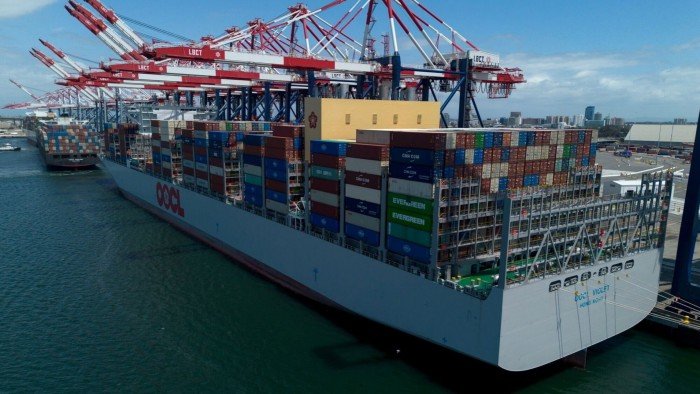
Stay informed with free updates
Simply sign up to the US trade myFT Digest — delivered directly to your inbox.
The US trade deficit in goods surged to a record high in March as businesses frontloaded purchases ahead of President Donald Trump’s imposition of sweeping tariffs on imports.
The gap between imports and exports widened to $162bn in March, from $92.8bn at the same time in 2024, marking the highest figure on records stretching to the early 1990s, according to US Census Bureau.
The rise in the trade balance was almost entirely down to a surge in imports — especially those with a long shelf-life, such as cars, industrial materials and consumer goods.
The figures add weight to reports that US businesses have bulked up their inventories ahead of the introduction of steep tariffs by the Trump administration.
“The picture for [the first quarter of 2025] overall remains that President Trump’s tariff threats set off a rush to buy goods now rather than face higher prices later, prompting a startling surge in imports,” said Oliver Allen, senior US economist at Pantheon Macroeconomics.
The US president unveiled a series of so-called reciprocal tariffs on April 2, sparking a sharp sell-off in equities markets and an increase in the US government’s financing costs as investors priced in the risk that high tariffs would drive the US economy into recession and stunt global growth.
While the introduction of many of those tariffs was paused for 90 days on April 4, a 10 per cent baseline remains in place as does a levy of 145 per cent on most Chinese imports. Economists say that, even without the April 2 tariffs in place, the current scenario leaves US trade duties at their highest effective rate for more than a century.
The report comes ahead of the first estimate for first-quarter GDP, due out on Wednesday, which is expected to be distorted by the impact of frontloading.
Analysts polled by Reuters expect annualised quarterly growth of just 0.3 per cent — down from 2.4 per cent for the fourth quarter of last year.
But economists say the figures are likely to paint an overly negative picture of US growth.
“The GDP number will tell us very little,” said Isabelle Mateos y Lago, chief economist at BNP Paribas. “It’s going to be full of noise, and reflecting to a very large extent, the sum of imports.”
She added: “You’re going to need to look really under the hood to see what’s really happening.”
Economists expect a partial turnaround in the second quarter as imports fall and push up GDP.
“Today’s [trade] numbers do really highlight the risk that it may well be a negative GDP print and that is obviously setting us up for a very weak 2025,” said James Knightley, chief international economist at ING Bank “This is a big stockpiling effort to get ahead of tariffs . . . but we expect this to unwind pretty soon: ports data is already slowing.”
West coast ports such as Los Angeles have reported a sharp drop in cargo volumes in recent weeks, amid signs that vessels carrying products from China’s east coast are turning back.
Anecdotal reports of shortages in construction and industrial products originating from China have also started to emerge.
Additional reporting by George Steer in New York






